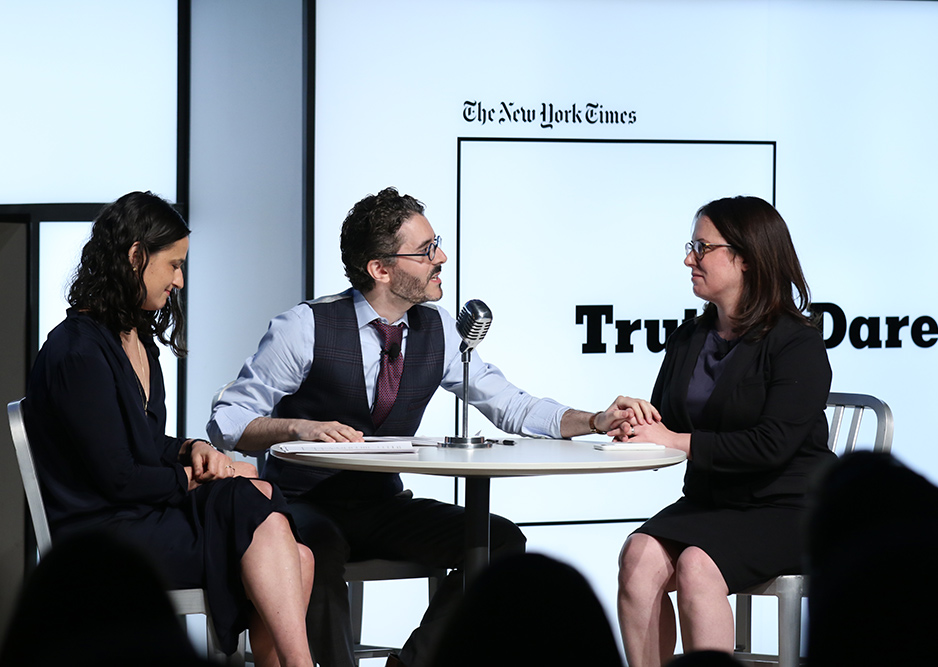Pitching agency executives and marketers on the depth and breadth of their pursuit of truth, The New York Times was the first media company to present at the annual Digital Content NewFronts on Monday, making a case for the importance their journalism plays at a global level.
The New York Times reported adding 308,000 net digital news subscriptions, making it the single best quarter for subscriber growth in their history, according to a Q1 earnings report released on Wednesday. While total revenues for in Q1 increased 5.1 percent to $398.8 million and with circulation driving that growth, total ad revenues fell by 6.9 percent despite digital advertising increasing by 19 percent year-over-year.
This particular NewFronts was a key platform for the media organization, who in a time of fake news proliferation, reemphasized their century-long message of building trust with readers and seeking the facts.
Focusing less on video (a common theme from this year’s presentations so far), company executives used the NewFronts stage for a two-hour presentation to showcase their journalists, produce a live podcast, discuss service journalism and flaunt T Brand Studio’s forthcoming films, virtual and augmented reality projects and Snapchat strategy. The underlying message “dared” marketers to co-create content with them.
Sebastian Tomich, senior vice president of advertising and innovation at The New York Times, joined AListDaily to detail how they are going to carry the NewFronts momentum throughout the rest of the year and use their newsroom as a launching point for branded campaigns.

Why is NewFronts such an imperative event for The New York Times?
We’re all-in on the ideas business. We’re putting our chips in for winning these “winner-take-all” briefs that we see come across our desk more and more. We want to win all of them . . . For the first half of the show, we talked about our journalism and our brand broadly to get people excited. In the back half, it was more about packages, formats and case studies that we’ve done on the advertising side.
In light of the public back-and-forth with President Donald Trump, how is your strategy and message different this time from the past?
I would like to think that our NewFronts presentation was completely independent of anything to do with Donald Trump. You can say that he’s contributed to a moment right now for journalism and high-quality publishing brands like never before. We definitely want to take advantage of that. Our “The Truth Is Hard” campaign had elements that would appeal to the controversy around Trump. That’s something we also leaned in on for NewFronts in a way that we haven’t before. The “Truth+Dare” tagline was more about us saying there is value in truth. There is value in high-quality journalism. It’s about what you can do with that in a daring fashion, and what makes the things that we do with advertisers special. Those were themes that we kept reiterating throughout the entire show—we don’t market ourselves as a transactional media business, where you come to us just to make a generic VR film, video or podcast. You come to us because you want to do groundbreaking work. If you look back at the last four years, all of our investments have planted us in that direction. We believe the future of our ad business will live and die on our ability to get groundbreaking ideas off the ground. We’ve invested in the teams and capabilities for all of these new businesses, like VR and audio, in order to do that.
What are some key categories in which you’re looking to earn brand trust and advertiser spending money?
The magic of The Times is that we get to play in so many key categories. We have a sizable Broadway and live entertainment business just as much as we do in auto. That’s exciting because you get to play in so many different verticals . . . Legacy lifestyle categories, like fine arts, live entertainment, travel, luxury and fashion skew more toward our editorial pillars, like a Sunday Travel section, versus custom. The broad message of innovation applies to everyone with big, creative ideas. In terms of the programs that we’ll launch, I think they’ll probably skew more toward auto, tech, finance and consumer packaged goods categories.
How are you positioning the T Brand Studio? Why are brands increasingly leaning toward branded content? How do you see the branded storytelling space developing?
It continues to grow significantly again this year. The advertisers that we work with continually lean on T Brand Studio to do high-quality work. By taking a premium position, we’ve been able to carve out a unique space for us. We’re not commoditized content in any way, shape or form. For some marketers that we work with, I’ve seen a trend of them having in-house studios, but they still tend to lean on us for content strategy, scripting and talent. So we still play a role and co-create together. We might just not handle the end production. The big headlines for T Brand Studio are our expansion into new lines of business like social influencers, experiential, VR and AR production, and beginning to dabble in content strategy work where we’re being engaged as a consultant to help brands think more like a newsroom. I’m really excited about that. There is so much room to grow. At NewFronts, we presented some of our best programs of the year with Tiffany, IBM and Kia, and how they took advantage of everything we have at our disposal. It’s a huge part and driver of our business.
How are you leveraging brand safety positioning in light of YouTube and Facebook’s ad issues and platform miscues?
We did a session on brand safety at NewFronts for the audience. We spoke about how JPMorgan Chase shifted from running on 400,000 sites to 5,000, and they still managed to keep performance consistent. We also talked about Facebook and Google’s earnings, and even in light of the brand safety issues, their earnings are still strong. I and many others in the industry believe Facebook and Google will be fine. They’ll continue to be facilitators for the majority of the ad business—brand safety issues or not. When we do go to market, we always talk about the power of our brand, and the fact that it’s a quality environment. But brands always knew they were already going to get that. The only place where there’s a real, tangible impact on brand safety on investment is in the programmatic space. Brands are either reaching out to work with us directly in programmatic by carving out specific pieces of inventory, or section-specific buys. The other is having some brands go out publicly and saying that “we’re not going to work with Google or Facebook on programmatic buys until they sort out some of their issues.” That’s a place where we don’t necessarily benefit from, but we have to react and work with others.
Why are podcasts now a big part of your strategy?
It’s a place where we can take a leadership position. Lisa Tobin, The Times’s executive producer for audio, said that the challenging part of the audio space is just finding stories. We have an incredible newsroom not only today but back to the first day we started, with a trove of stories. We can lead in the space. So when we think about the audio business, Sam Dolnick, the assistant masthead editor, said at NewFronts that “when we go into a new medium, we go in to tell the same quality of stories—and we want to go big and reach millions of people.” The success of our The Daily podcast [27 million downloads], which was just expanded from five days to seven and is now available on Spotify, has galvanized the newsroom to realize the opportunities of how many other types of podcasts we can do as well. You will see more from us in the next 12-to-18 months. You’ll see it across many verticals [like S-Town and Serial podcasts] and not just news.
Why are brands, like your launch partner in BMW and Samsung too, interested in sponsoring podcasts? Is it a successful move for them?
There is a lot of interest for sure. We only have two models. You either advertise in our podcast, or we create a custom one for you. There is no such thing as product placement at The Times. There is a good amount of advertisers that just want to try the medium because there is so much interest. The founder of Spotify, Daniel Ek, said that the opportunity of getting into someone’s ear is better than the opportunity of getting in front of someone’s eyes. It’s a huge engagement opportunity. The brand-led podcast space in generally immature. Who knows where that’s going to end up. I know brands like General Electric have had success with the message, but I haven’t seen a whole lot after that. For us, most of the work we have is tried and true audio spots around our newsroom podcasts.
Last year the NYT’s big push was behind VR. How are you now scaling the platform?
It’s like the same theme as audio—we want to tell mission-driven stories in new ways like we always have. If you look at VR, it’s almost like a variation of the same playbook. We want to scale and go big. We launched the app, and I believe we are the largest publisher VR app there is in media. The newsroom continues to do about one film a month. The next evolution for us is how to blend VR into bigger stories that we’re reporting on so that VR becomes an add-on and allows readers to experience a 1,500 story differently. You’ll see that with our upcoming piece that we’re working on about Antarctica. And then, our work with platforms. I don’t have anything to announce right now, but you can imagine that we’re going to have growing presence on VR platforms by the end of the year.
How do you plan to keep building your presence on Snapchat?
Snapchat is more unique because it’s a contained platform. It’s a walled garden, where you’re only creating content specific to that platform. Our relationship with them is a little bit more unique, where we’re actually creating a Snapchat-specific publication that runs once a day for the entire year. We saw it as a great opportunity to reach new audiences and experiment with new formats, and in some cases, tell new stories. That’s an exciting thing for us—to reach new, younger readers. I would say the biggest motivation is for our New York Times brand and just making sure that we’re in the hands of all of our future subscribers.
Follow Manouk Akopyan on Twitter @Manouk_Akopyan

